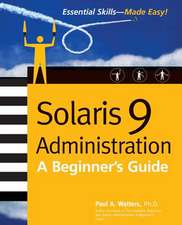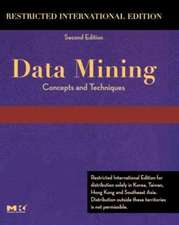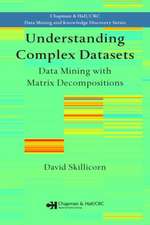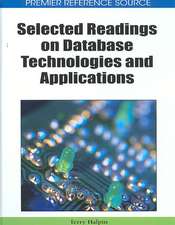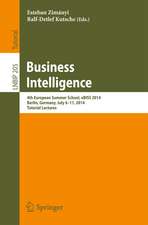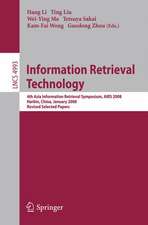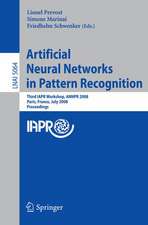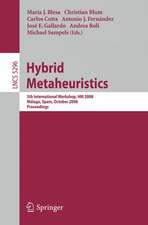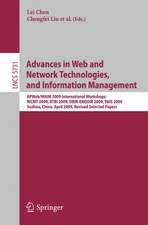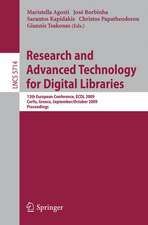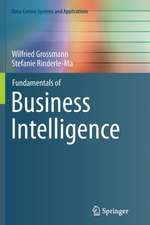Context-Aware Machine Learning and Mobile Data Analytics: Automated Rule-based Services with Intelligent Decision-Making
Autor Iqbal Sarker, Alan Colman, Jun Han, Paul Wattersen Limba Engleză Hardback – 2 dec 2021
| Toate formatele și edițiile | Preț | Express |
|---|---|---|
| Paperback (1) | 924.15 lei 6-8 săpt. | |
| Springer International Publishing – 3 dec 2022 | 924.15 lei 6-8 săpt. | |
| Hardback (1) | 930.41 lei 6-8 săpt. | |
| Springer International Publishing – 2 dec 2021 | 930.41 lei 6-8 săpt. |
Preț: 930.41 lei
Preț vechi: 1163.00 lei
-20% Nou
Puncte Express: 1396
Preț estimativ în valută:
178.03€ • 186.38$ • 147.31£
178.03€ • 186.38$ • 147.31£
Carte tipărită la comandă
Livrare economică 05-19 aprilie
Preluare comenzi: 021 569.72.76
Specificații
ISBN-13: 9783030885298
ISBN-10: 3030885291
Ilustrații: XVI, 157 p. 41 illus., 31 illus. in color.
Dimensiuni: 155 x 235 mm
Greutate: 0.43 kg
Ediția:1st ed. 2021
Editura: Springer International Publishing
Colecția Springer
Locul publicării:Cham, Switzerland
ISBN-10: 3030885291
Ilustrații: XVI, 157 p. 41 illus., 31 illus. in color.
Dimensiuni: 155 x 235 mm
Greutate: 0.43 kg
Ediția:1st ed. 2021
Editura: Springer International Publishing
Colecția Springer
Locul publicării:Cham, Switzerland
Cuprins
Part I Preliminaries.- 1 Introduction to Context-Aware Machine Learning and Mobile Data.- Analytics.- 1.1 Introduction.- 1.2 Context-Aware Machine Learning.- 1.3 Mobile Data Analytics.- 1.4 An Overview of this Book.- 1.5 Conclusion.- References.- 2 Application Scenarios and Basic Structure for Context-Aware.- Machine Learning Framework.- 2.1 Motivational Examples with Application Scenarios.- 2.2 Structure and Elements of Context-Aware Machine Learning.- Framework.- 2.2.1 Contextual Data Acquisition.- 2.2.2 Context Discretization.- 2.2.3 Contextual Rule Discovery.- 2.2.4 Dynamic Updating and Management of Rules.- 2.3 Conclusion.- References.- 3 A Literature Review on Context-Aware Machine Learning and.- Mobile Data Analytics.- 3.1 Contextual Information.- 3.1.1 Definitions of Contexts.- 3.1.2 Understanding the Relevancy of Contexts.- 3.2 Context Discretization.- 3.2.1 Discretization of Time-Series Data.- 3.2.2 Static Segmentation.- vii.- viii Contents.- 3.2.3 Dynamic Segmentation.- 3.3 Rule Discovery.- 3.3.1 Association Rule Mining.- 3.3.2 Classification Rules.- 3.4 Incremental Learning and Updating.- 3.5 Identifying the Scope of Research.- 3.6 Conclusion.- References .- Part II Context-Aware Rule Learning and Management.- 4 Contextual Mobile Datasets, Pre-processing and Feature Selection.- 4.1 Smart Mobile Phone Data and Associated Contexts.- 4.1.1 Phone Call Log.- 4.1.2 Mobile SMS Log.- 4.1.3 Smartphone App Usage Log.- 4.1.4 Mobile Phone Notification Log.- 4.1.5 Web or Navigation Log.- 4.1.6 Game Log.- 4.1.7 Smartphone Life Log.- 4.1.8 Dataset Summary.- 4.2 Examples of Contextual Mobile Phone Data.- 4.2.1 Time-Series Mobile Phone Data.- 4.2.2 Mobile phone data with multi-dimensional contexts.- 4.2.3 Contextual Apps Usage Data.- 4.3 Data Preprocessing.- 4.3.1 Data Cleaning.- 4.3.2 Data Integration.- 4.3.3 Data Transformation.- 4.3.4 Data Reduction.- 4.4 Dimensionality Reduction.- 4.4.1 Feature Selection.- 4.4.2 Feature Extraction.- 4.4.3 Dimensionality Reduction Algorithms.- 4.5 Conclusion.- References.- 5 Discretization of Time-Series Behavioral Data and Rule Generation.- based on Temporal Context.- 5.1 Introduction.- 5.2 Requirements Analysis.- 5.3 Time-series Segmentation Approach.- 5.3.1 Approach Overview.- 5.3.2 Initial Time Slices Generation.- 5.3.3 Behavior-Oriented Segments Generation.- Contents ix.- 5.3.4 Selection of Optimal Segmentation.- 5.3.5 Temporal Behavior Rule Generation using Time Segments.- 5.4 Effectiveness Comparison.- 5.5 Conclusion.- References.- 6 Discovering User Behavioral Rules based on Multi-dimensional.- Contexts.- 6.1 Introduction.- 6.2 Multi-dimensional Contexts in User Behavioral Rules.- 6.3 Requirements Analysis.- 6.4 Rule Mining Methodology.- 6.4.1 Identifying the Precedence of Context.- 6.4.2 Designing Association Generation Tree.- 6.4.3 Extracting Non-Redundant Behavioral Association Rules.- 6.5 Experimental Analysis.- 6.5.1 Effect on the Number of Produced Rules.-6.5.2 Effect of Confidence Preference the Predicted Accuracy.- 6.5.3 Effectiveness Comparison.- 6.6 Conclusion.- References.- 7 Recency-based Updating and Dynamic Management of Contextual.- Rules.- 7.1 Introduction.- 7.2 Requirements Analysis.- 7.3 An Example of Recent Data.- 7.4 Identifying Optimal Period of Recent Log Data.- 7.4.1 Data Splitting.- 7.4.2 Association Generation.- 7.4.3 Score Calculation.- 7.4.4 Data Aggregation.- 7.5 Machine Learning based Behavioral Rule Generation and Management.- 7.6 Effectiveness Comparison and Analysis.- 7.7 Conclusion.- References.- Part III Application and Deep Learning Perspective.- 8 Context-Aware Rule-based Expert System Modeling.- 8.1 Structure of a Context-Aware Mobile Expert System.- 8.2 Context-Aware Rule Generation Methods.- 8.3 Context-Aware IF-THEN Rules and Discussion.- 8.3.1 IF-THEN Classification Rules.- 8.3.2 IF-THEN Association Rules.- x Contents.- 8.4 Conclusion.- References .- 9 Deep Learning for Contextual Mobile Data Analytics.- 9.1 Introduction.- 9.2 Contextual Data.- 9.3 Deep Neural Network Modeling.- 9.3.1 Model Overview.- 9.3.2 Input Layer.- 9.3.3 Hidden Layer(s).- 9.3.4 Output Layer.- 9.4 Prediction Results of the Model.- 9.5 Conclusion.- References.- 10 Context-Aware Machine Learning System: Applications and.- Challenging Issues.- 10.1 Rule-based Intelligent Mobile Applications.- 10.2 Major Challenges and Research Issues.- 10.3 Concluding Remarks.- References.
Notă biografică
Iqbal H. Sarker received his Ph.D. under the department of Computer Science and Software Engineering from Swinburne University of Technology, Melbourne, Australia in 2018. Currently, he is working as a faculty member of the Department of Computer Science and Engineering at Chittagong University of Engineering and Technology. He is one of the Research Founder of the International AIQT Foundation, Switzerland. His professional and research interests include - Data Science, Machine Learning, AI-Driven Computing, Cybersecurity Intelligence, Behavioral Analytics, Context-Aware Computing and IoT-Smart City Technologies. He has over 100 publications in leading venues including Journals (Journal of Network and Computer Applications – Elsevier, USA; Internet of Things – Elsevier; Expert Systems with Applications – Elsevier, UK; Journal of Big Data – Springer Nature, UK; Mobile Network and Applications – Springer, Netherlands; The Computer Journal, Oxford University Press, UK; IEEE Transactions on Artificial Intelligence, IEEE Access, USA and so on) and Conferences such as IEEE DSAA, IEEE Percom, ACM Ubicomp, ACM Mobiquitous, Springer LNCS PAKDD, Springer LNCS ADMA and so on. He is a member of IEEE and ACM.
Alan Colman: is an Adjunct Research Fellow in Software Engineering at Swinburne University of Technology, Melbourne. His main research focus is on adaptive service-oriented systems and architectures. He has also made research contributions to feature-oriented software engineering, context-aware computing, control-theoretic adaptation and performance prediction of software systems, and user-centric access control and data sharing with blockchain. He has over 150 publications in leading software journals and conference proceedings with over 2300 citations to his papers.
Jun Han: received his Ph.D. in Computer Science from the University of Queensland. Since 2003, he has been Professor of Software Engineering at Swinburne University of Technology. He has authored two books and published over 260 peer-reviewed articles in leading international journals and conferences. His current research interests include adaptive and context-aware systems, services and cloud systems engineering, software and service behavior mining, data-driven software engineering, software architectures, software security and performance
Paul Watters: Professor Paul A. Watters is Academic Dean at Academies Australasia Polytechnic, an ASX-listed higher education provider operating 18 colleges in Australia and Singapore. Professor Watters is also Honorary Professor of Security Studies and Criminology at Macquarie University, and Adjunct Professor of Cyber Security at La Trobe University. He has worked closely with many large companies and law enforcement agencies in Australia on applied cyber R&D projects, and he has written many books and academic papers on cybersecurity, cybercrime andrelated topics. His research has been cited 4,964 times, and his h-index is 33. He obtained his PhD at Macquarie University in 2000, and read for his MPhil at the University of Cambridge in 1997 after completing a BA(First Class Honours) at the University of Tasmania, and a BA at the University of Newcastle. Professor Watters is a Fellow of the British Computer Society, a Senior Member of the IEEE, a Chartered IT Professional, and a Member of the Australian Psychological Society.
Textul de pe ultima copertă
This book offers a clear understanding of the concept of context-aware machine learning including an automated rule-based framework within the broad area of data science and analytics, particularly, with the aim of data-driven intelligent decision making. Thus, we have bestowed a comprehensive study on this topic that explores multi-dimensional contexts in machine learning modeling, context discretization with time-series modeling, contextual rule discovery and predictive analytics, recent-pattern or rule-based behavior modeling, and their usefulness in various context-aware intelligent applications and services. The presented machine learning-based techniques can be employed in a wide range of real-world application areas ranging from personalized mobile services to security intelligence, highlighted in the book. As the interpretability of a rule-based system is high, the automation in discovering rules from contextual raw data can make this book more impactful for the application developers as well as researchers. Overall, this book provides a good reference for both academia and industry people in the broad area of data science, machine learning, AI-Driven computing, human-centered computing and personalization, behavioral analytics, IoT and mobile applications, and cybersecurity intelligence
Caracteristici
Presents a comprehensive study and highlights the usefulness of the concept of context-aware machine learning Introduces an automated rule-based machine learning framework to effectively analyze and discover rules Highlights how contextual information can be used in various real-world smart and intelligent applications

